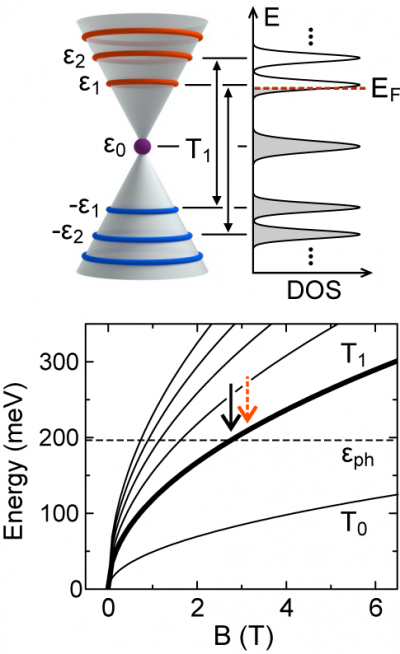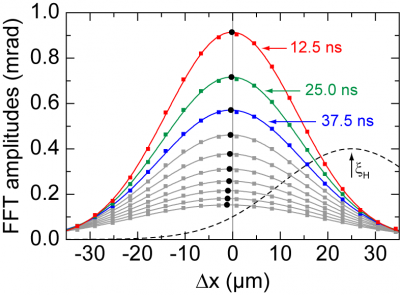Current events
Next talk on Tuesday in 2 days by Katrin Hecker.
News 06.06.2025
New publication:Anisotropic supercurrent suppression and revivals in a graphene-based Josephson junction under in-plane magnetic fields
Site Content:
04.05.2018
New publication: Impact of Many-Body Effects on Landau Levels in Graphene

Phys. Rev. Lett. 120, 187701(2018) We present magneto-Raman spectroscopy measurements on suspended graphene to investigate the charge carrier density-dependent electron-electron interaction in the presence of Landau levels. Utilizing gate-tunable magnetophonon resonances, we extract the charge carrier density dependence of the Landau level transition energies and the associated effective Fermi velocity vF. In contrast to the logarithmic divergence of vF at zero magnetic field, we find a piecewise linear scaling of F as a function of the charge carrier density, due to a magnetic-field-induced suppression of the long-range Coulomb interaction. We quantitatively confirm our experimental findings by performing tight-binding calculations on the level of the Hartree-Fock approximation, which also allow us to estimate an excitonic binding energy of ≈6 meV contained in the experimentally extracted Landau level transitions energies.

02.05.2018
New publication: Time-resolved lateral spin-caloric transport of optically generated spin packets in n-GaAs

Journal of Physics D: Applied Physics 51, 214003(2018) We report on lateral spin-caloric transport (LSCT) of electron spin packets which are optically generated by ps laser pulses in the non-magnetic semiconductor n-GaAs at T < 35 K. LSCT is driven by a local temperature gradient induced by an additional cw heating laser. The spatio-temporal evolution of the spin packets is probed using time-resolved Faraday rotation. We demonstrate that the local temperature-gradient induced spin diffusion is solely driven by a non-equilibrium hot spin distribution, i.e. without involvement of phonon drag effects.

23.04.2018
New publication: Quantum transport through MoS2 constrictions defined by photodoping

Journal of Physics: Condensed Matter 30, 205001(2018) We present a device scheme to explore mesoscopic transport through molybdenum disulfide (MoS2) constrictions using photodoping. The devices are based on van-der-Waals heterostructures where few-layer MoS2 flakes are partially encapsulated by hexagonal boron nitride (hBN) and covered by a few-layer graphene flake to fabricate electrical contacts. Since the as-fabricated devices are insulating at low temperatures, we use photo-induced remote doping in the hBN substrate to create free charge carriers in the MoS2 layer. On top of the device, we place additional metal structures, which define the shape of the constriction and act as shadow masks during photodoping of the underlying MoS2/hBN heterostructure. Low temperature two- and four-terminal transport measurements show evidence of quantum confinement effects.

19.04.2018
Race report Bonn Marathon 2018
Our institute participated successfully in the "Deutsche Post Marathon 2018" in Bonn. Together with 13,000 other participants, over 200,000 spectators and best weather, Markus (1:35:29), Alex (1:52:06) and Luca (1:54:21) completed the Half Marathon course while Michael ran the full Marathon in 3:23:16. Congratulations!
_orig.JPG)

31.03.2018
Söllerhaus-Workshop 2018
The Söllerhaus-Workshop 2018 from the 28th to the 31st of March of the 2nd Institute of Physics A and B focusing on "2D materials" was great fun with many interesting talks and discussions and lots of good snow. For more information on the program see here.


22.03.2018
New publication: Tailoring Mechanically Tunable Strain Fields in Graphene

Nano Letters 18, 1707 (2018) There are a number of theoretical proposals based on strain engineering of graphene and other two-dimensional materials, however purely mechanical control of strain fields in these systems has remained a major challenge. The two approaches mostly used so far either couple the electrical and mechanical properties of the system simultaneously or introduce some unwanted disturbances due to the substrate. Here, we report on silicon micromachined comb-drive actuators to controllably and reproducibly induce strain in a suspended graphene sheet in an entirely mechanical way. We use spatially resolved confocal Raman spectroscopy to quantify the induced strain, and we show that different strain fields can be obtained by engineering the clamping geometry, including tunable strain gradients of up to 1.4%/μm. Our approach also allows for multiple axis straining and is equally applicable to other two-dimensional materials, opening the door to investigating their mechanical and electromechanical properties. Our measurements also clearly identify defects at the edges of a graphene sheet as being weak spots responsible for its mechanical failure.

21.03.2018
New publication: Mesoporous manganese phthalocyanine-based materials for electrochemical water oxidation via tailored templating
Catal. Sci. Technol. 8, 1517 (2018) Electrochemical water splitting using non-noble metals as catalysts is of increasing importance for the future energy sector. In particular, efficient catalysts for the demanding oxygen evolution reaction present a major challenge. As a contribution to this field, tailored mesoporous hard template materials based on manganese phthalocyanine were prepared. The preparation method proved to be crucial to achieve suitable physicochemical properties as a basis for high catalytic activity. The materials show overpotentials between 490 and 590 mV at 10 mA cm−2 This can be mainly attributed to efficient graphitization, high Mn dispersion and tailored oxidation states.

08.03.2018
New book chapter publication: Characterization of Graphene by Confocal Raman Spectroscopy

Confocal Raman Microscopy, pp 177-184 (2018), Part of the Springer Series in Surface Sciences Confocal Raman spectroscopy has emerged as a key characterization technique in graphene research, as with this technique important material characteristics can be obtained locally and noninvasively. In this chapter, the fundamentals of the Raman spectrum of graphene are reviewed and the utilization of Raman spectroscopy for graphene characterization is demonstrated. In this regard, we show how crucial properties of graphene samples, i.e. doping , strain , defect-density and layer-number can be extracted from the Raman spectrum. Accessing these quantities is highly relevant for monitoring, understanding and improving graphene synthesis processes and device fabrication techniques for research and emerging industrial applications.

